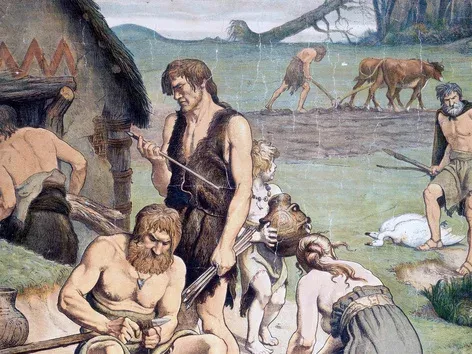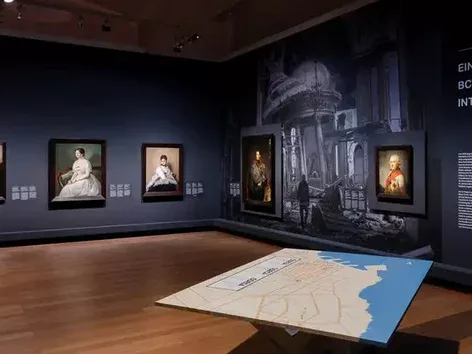Half of humanity may be descended from Yamnaya culture that lived on the territory of Ukraine: research details

Discoveries related to the Yamnaya culture shed light on the processes of ethnogenesis of many modern peoples. At the same time, they are sparking a new round of debate among geneticists, linguists and archaeologists alike. Nevertheless, scientists are already confident that many modern societies. And it was their cultural and technological influence that, five thousand years before Christ, became one of the decisive factors in shaping the modern world
According to a study published in The Wall Street Journal, about four billion modern people around the world may carry the genes of the ancient Yamnaya culture, which existed on the territory of modern Ukraine about five thousand years ago. The results of DNA analysis and archaeological findings are forcing scientists to seriously reconsider the contribution of this people to the genetic and cultural heritage of Europe and much of Eurasia.
New data on the origin of the Yamnaya culture
A group of researchers led by geneticist David Reich of Harvard Medical School conducted a large-scale study that involved analysing ancient DNA samples obtained from the remains of people living in different parts of Europe and comparing genetic data with archaeological and linguistic evidence.
Based on these materials, the scientists concluded that around three millennia before Christ (around 3000 BC), a previously unknown group of people migrated from the Volga River region to lands north of the Black Sea (the present-day Ukrainian steppes). There, the newcomers mixed with local tribes, forming a new culture called the Yamna culture.
Features of the Yamnaya culture
The name comes from the word ‘pit’, because the representatives of this culture buried their leaders and high-ranking members of society in specially dug pits under mounds. Pit culture is also notable for other factors:
🔻 Horse riding and wheeled carts. According to scientists, Yamnaya people were among the first to master horse riding and start using wheeled vehicles. This gave them a huge advantage when travelling long distances.
🔻 Social hierarchy. Archaeological findings indicate a developed system of leadership and reverence for high-status individuals.
According to the researchers, these factors contributed to the large-scale migration of the Yamnaya culture outside the Black Sea region.
Genetic cradle and migration routes
The main region that scientists call the ‘cradle’ of the Yamnaya culture is the Mykhailivske settlement (Ukraine), which is currently under Russian occupation. From there, the Yamnaya culture carriers spread to large areas of Eurasia, from Portugal in the west to Mongolia in the east. Their migrations laid the foundation for future globalisation, as they spread along with people:
1. Genetic material that later defined some of the modern human populations;
2. Culture and way of life: farming skills, ways of travelling, elements of social organisation;
3. language or, more precisely, the linguistic basis, which could later be transformed and developed into dozens of new dialects and languages.
Don't want to miss important updates and useful articles? Subscribe to our weekly newsletter!
The language of the Yamnaya culture and its descendants
Although the Yamnaya culture left no written records, many scholars believe that their language or languages served as the basis for a large family of modern Indo-European languages. More than 400 languages - including Latin, Greek, English, Russian, Urdu, and German - can be traced back to a common linguistic ‘root’. However, according to scientists, this hypothesis has not yet been conclusively proven, and more research is needed.
The large-scale migration of the Yamniks to different regions of Eurasia was reflected not only in cultural artefacts but also in the genetic makeup of the local population. Scientists note that indigenous men in many areas are ‘disappearing’ from the genetic pool, while the lines of local women continue to be traced in descendants. This situation probably indicates the conquering nature of the Yamnaya culture migration: men from the newly arrived tribes married indigenous women, and as a result, the gene pool of the male part of the indigenous peoples gradually became a thing of the past. Archaeologists and historians call this ‘cultural erasure’ - when both the language and customs of the indigenous population are gradually replaced or completely replaced by the culture of the conquerors.
Influence on the formation of Europe and the modern world
Many influential ancient peoples, including the Romans, Celts, Persians, and Macedonians, could inherit not only part of the genetic material from the Yamnaya culture, but also numerous elements of life and economy.
According to David Reich, this meant a dramatic change in the population of Europe and ultimately affected the genetic heritage of much of the world. The researchers believe that it was the migrations of the pitmen that laid the foundation for the formation of various cultural and linguistic communities, which later became the foundation of the modern Western and then global world order.
We remind you! An exhibition of old photographs of Crimea called YILLAR VE YOLLAR has opened in the Crimean House. This is a unique opportunity for everyone to plunge into the atmosphere of the peninsula in the early twentieth century.
Want to know more? Read the latest news and useful materials about Ukraine and the world in the News section.
We recommend purchasing it for a safe and comfortable trip to Ukraine:
Visit Ukraine Insurance – insurance covering military risks for entry and travel in Ukraine;
Visit Ukraine Car Insurance – car insurance with extended coverage in Ukraine;
Visit Ukraine Legal Advice – comprehensive legal support on entry to Ukraine;
Visit Ukraine Tickets – bus and train tickets to/from Ukraine;
Visit Ukraine Tours – the largest online database of tours to Ukraine for every taste;
Visit Ukraine Hotels – hotels for a comfortable stay in Ukraine;
Visit Ukraine Merch – patriotic clothing and accessories with worldwide delivery.
© 2018-2025, Visit Ukraine. Use, copying or reprinting of materials on this site is permitted only with a link (hyperlink for online publications) to Visit Ukraine.
All rights reserved.
Recommended articles
1 min
Events
An exhibition of paintings evacuated from Odesa opened in Berlin: what works are presented
The paintings of the Odesa Museum of Western and Oriental Art are presented as part of an exhibition at the Berlin Art Gallery. Find out what masterpieces are on display there and what you need to know about the event itself
31 Jan. 2025
More details1 min
Events
Ukraine commemorates the Heavenly Hundred Heroes - people who changed the country
The Day of the Heavenly Hundred Heroes is not only a commemoration of the fallen, but also a reminder of the strength of spirit and the desire for freedom demonstrated by thousands of Ukrainians in the winter of 2013-2014. Their feat continues to inspire new generations of Ukrainian defenders, and their memory strengthens the unity of the nation in the fight for sovereignty and democratic values
20 Feb. 2025
More details1 min
Events
Lent 2025. When does it start and what is forbidden during this period?
Easter is one of the most important holidays for all Christian believers. However, no less important is the period before the holiday, which prepares people for the Resurrection of Christ. Find out why we need Lent and what rules we need to follow
02 Mar. 2025
More details1 min
Culture
Oscar 2025: the names of all the winners and what the ceremony was remembered for
A new Oscar ceremony took place in Los Angeles. The Porcelain War, a co-production of Ukraine, Australia and the United States, was nominated for the Best Feature Documentary Award. Find out who won in which nominations
03 Mar. 2025
More details

